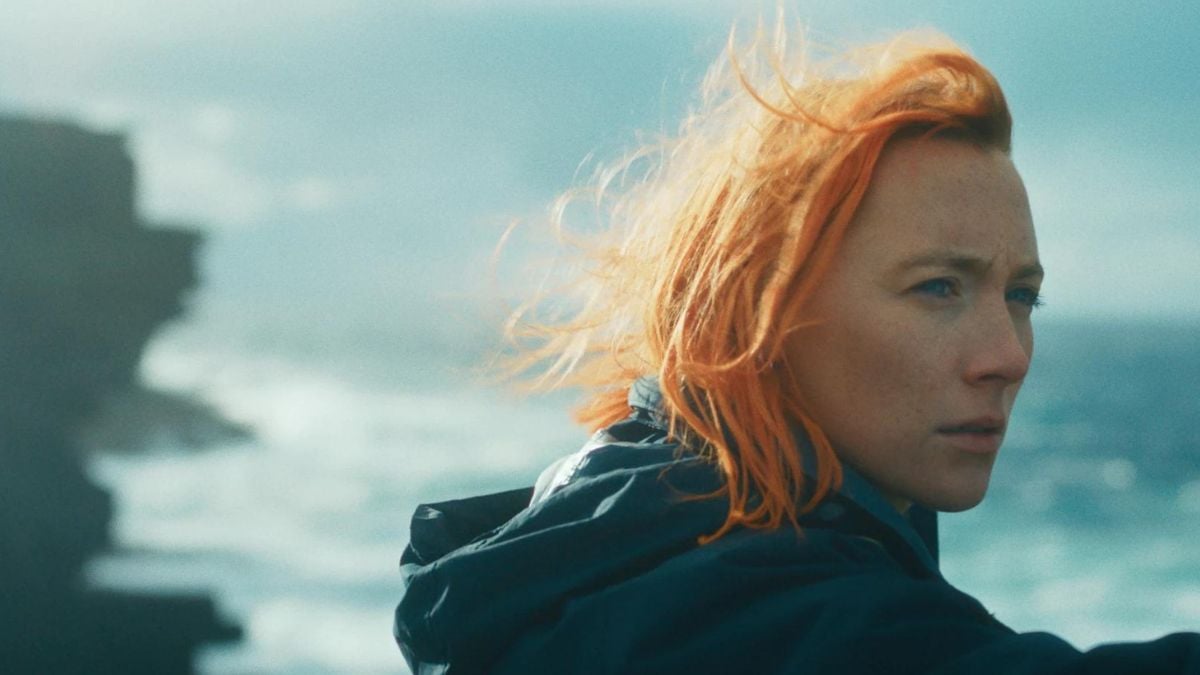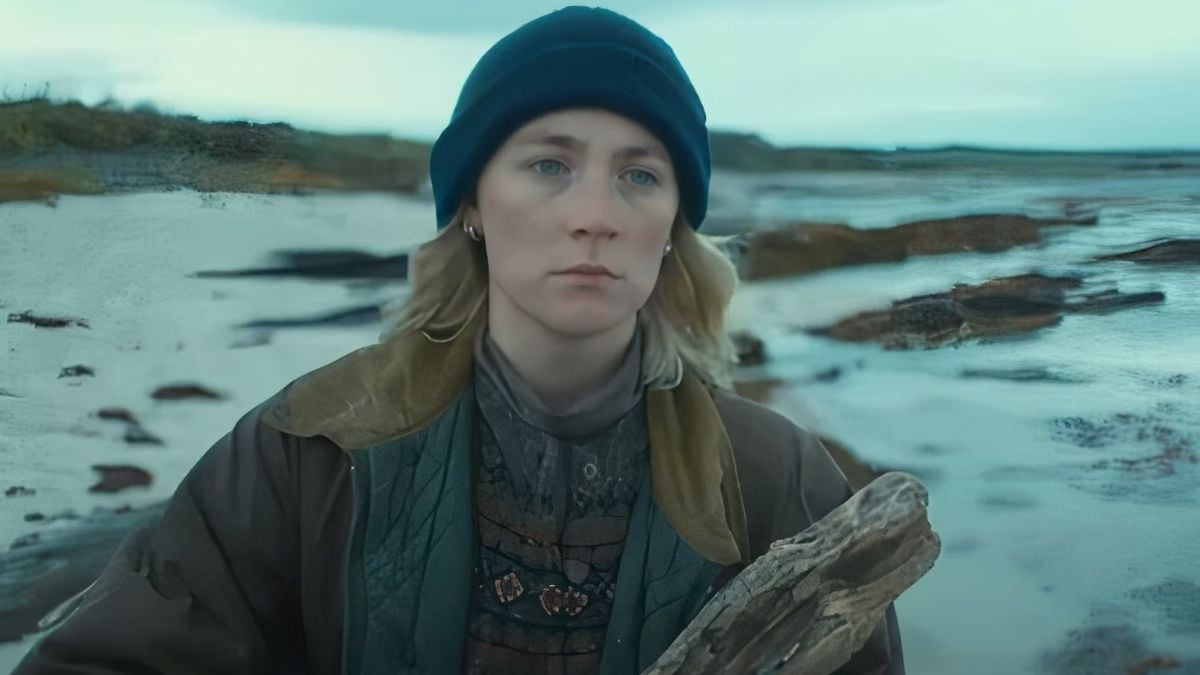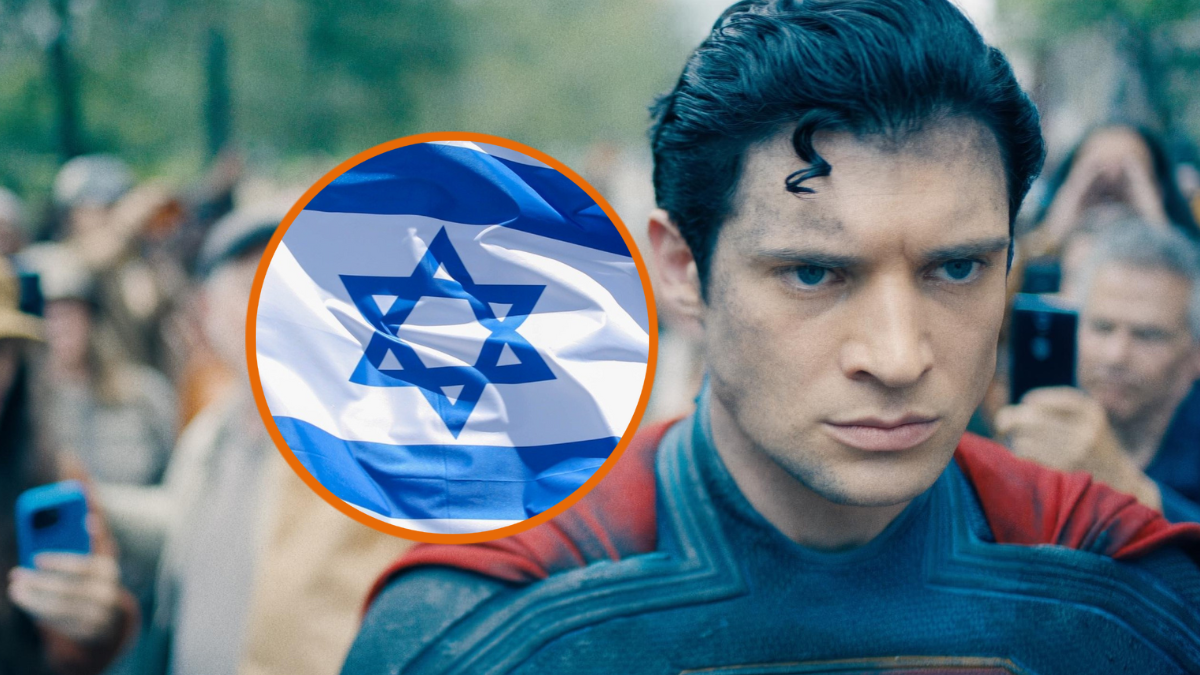Since her breakout role in Joe Wright’s Atonement, Saoirse Ronan has been collecting Academy Awards nominations. If there’s justice in the world, The Outrun will finally give her a win.
Set in the remote Orkney Islands, in the north of Scotland, The Outrun follows Ronan as Rona, a young woman recovering from alcohol addiction. Instead of a linear story, the movie offers a rich tapestry that slowly unveils Rona’s challenging family relationships, the depths of her self-destructive behavior, and the struggle to regain control of her life. While that sounds like the perfect recipe for a gripping drama, The Outrun’s unusual structure turns it into a challenging watch.
The Outrun constantly jumps back and forth in time, each scene a new piece of the puzzle of Rona’s life. In one moment, we watch as Rona tries to settle into the quiet routine of the Orkney Islands, where she helps her father run the family farm. Next, we are taken to one of the unnerving drinking episodes in which she puts herself at risk and harms the people closer to her. In between, we also get glimpses of Rona before she became an alcoholic, a time when drinking and partying seemed just casual fun to a young woman and her friends.
The twisty presentation of Rona’s story reflects the chaos of alcoholism, as past mistakes echo in the future, and someone’s whole progress in the fight against addiction can suddenly unravel. Life rarely moves in a straight line, and living can be an agonizing experience for some people, which is one of the main reasons for abusing alcohol. That is to say, there is an argument in favor of director Nora Fingscheidt’s approach to storytelling. Even so, The Outrun can be confusing for these reasons, especially in the first minutes of projection.
Before you know all the characters that shape Rona’s life and where they fit in her journey through addiction, the only clue to create a coherent timeline is the different colors and cuts of Rona’s hair. Again, once you understand when each hairstyle was present, this becomes an essential tool for understanding the story progression. However, even that has a learning curve that not every viewer will appreciate. So, while there’s nothing wrong with how The Outrun tells Rona’s story, the movie can be alienating to the average moviegoer, making it hard to recommend without reservations.

What viewers must have in mind to appreciate what The Outrun does is that Fingscheidt’s latest project is less a movie and more a portrait. The Outrun isn’t particularly concerned with telling a story, at least not as much as offering a meditation on what pushes people to the path of addiction and how to deal with the troubling task of staying alive. Once audiences can accept that and let go of expectations, it becomes easier to connect with Rona and take part in her life’s emotional rollercoaster. And what a rollercoaster it is!
As particular as Rona’s journey might be, there’s something universal about the desperate human desire to make sense of the world around us. Unlike any other life form, we are asked to give meaning to our existence, a hopeless task that sometimes can be too heavy to bear. When that happens, alcohol can be an easy, legal, and highly accessible solution to numb synapses and drown anxiety, which is why it remains one of the most popular drugs in the world.
Even people who don’t drink can understand the contradictions and uncertainties that haunt Rona, an intrinsic part of being human. So, the fact the character has such a raw presence on the silver screen makes it easy to relate with the young woman. As a result, a packed screening of The Outrun is constantly accompanied by quiet sobbing, sometimes from you, sometimes from the seats by your side. Of course, if The Outrun can have this effect and leave such a strong impression, that’s thanks to Ronan’s ability to wear her heart on her sleeve.

To say Ronan is one of the best actresses of her generation is a platitude. There’s no honest criticism that can question her talent, especially when she already carried so many movies over her gifted shoulders – Lady Bird, Brooklyn, and Hanna, just to name a few. Yet, The Outrun showcases Ronan’s range, as few projects have done before. From the ecstasy of having drugs pumpin’ into your bloodstream to the despair that emerges after a night of blackout, Ronan can embody every nuance of the human spirit with an energy other performers take decades to master. Ultimately, she is the reason we care about Rona and understand her character so well.
The minimalistic script by Fingscheidt, Amy Liptrot, and Daisy Lewis leaves enough space for Ronan to occupy with her barrage of microexpressions, each capable of adding new layers to the broken woman at the story’s center. Despite some noticeable flaws, The Outrun works because the movie trusts Ronan will do her job and convey complex emotions even when she’s entirely alone and can’t use dialogue to express herself. Ronan’s presence keeps us glued to the screen, hanging on every note of the symphony she composes with her deep understanding of human nature. Her failure to win an Academy Award for this performance would be nothing short of a travesty.

The Outrun also deserves praise for how it bridges different moments of Rona’s history, showing how every trace of individuality people develop comes from the way they react to the wonder around them. Yes, Rona’s addictive tendencies can be explained by her childhood. Still, The Outrun also investigates how even the character’s musical taste can be traced back from something that her brain imprinted, and even if there is no apparent relationship between electronic music and the desolated greenness of Orkney Islands, both things are surprisingly connected. This kind of insight elevates the movie, rewarding spectators who pay close attention to the minor details of Rona’s life.
That said, The Outrun pushes its luck by sticking with a two-hour runtime. As brilliant as Ronan can be, she can’t justify the movie’s length, which would have been better if some things had been left in the editing room. There are just too many scenes of Rona contemplating the nature around her, and all of these scenes run a little too long. So, while The Outrun is not focused on the narrative side of filmmaking, the movie would nevertheless benefit from a little more focus.
Finally, The Outrun is frequently interrupted by Rona narrating that don’t quite fit with what we see on the screen. These divagations explain myths and historical events, serving as a record of the culture surrounding the Orkney Islands. While these fragments can be interesting by themselves, they steal the focus away from Rona, inflate the runtime, and can give the impression The Outrun might have a more fantastic turn further ahead — which, let’s be clear, it won’t.
For those reasons, not everyone will vibe with The Outrun, and that’s fine. While still a fascinating filmmaking exercise, this is, unfortunately, one of those movies you can recommend to everyone. Still, The Outrun is a vehicle for Ronan’s talent, with her driving fast towards awards season.
- Saoirse Ronan delivers an Oscar-worthy performance
- Emotionally resonant and relatable portrayal of human struggles
- Thoughtful exploration of how past experiences shape identity
- Beautiful cinematography showcasing the Orkney Islands
- Minimalist script allows for nuanced, non-verbal storytelling
- Non-linear structure may be confusing or alienating for some viewers
- Two-hour runtime feels excessive, with some scenes running too long
- Contemplative pacing makes it a challenging watch











Published: Oct 5, 2024 05:22 am